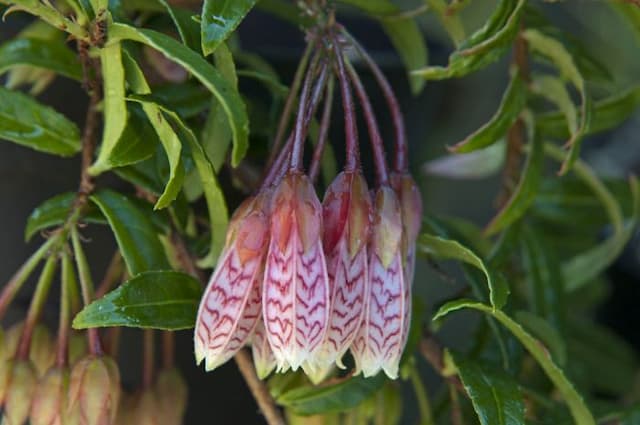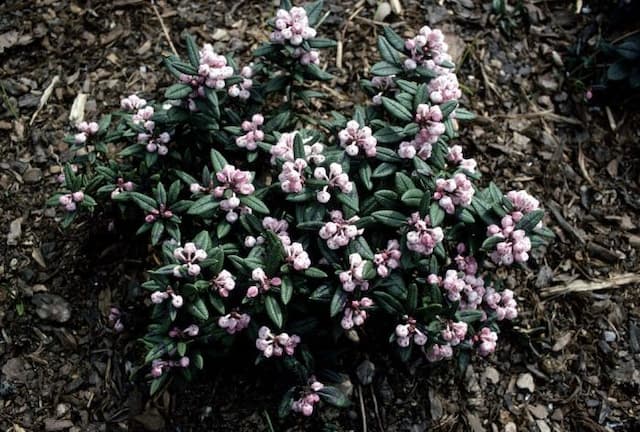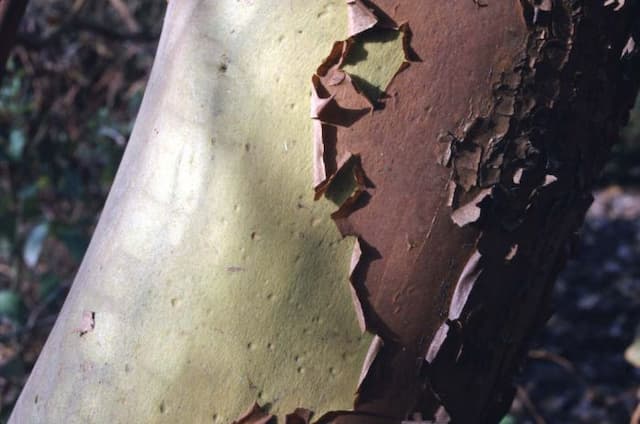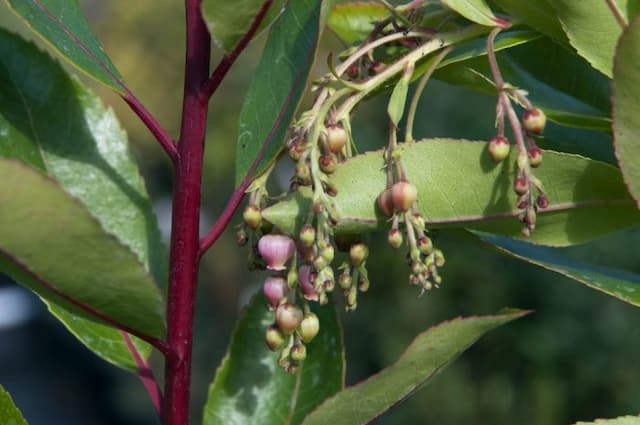Bog Rosemary Andromeda polifolia 'Compacta'
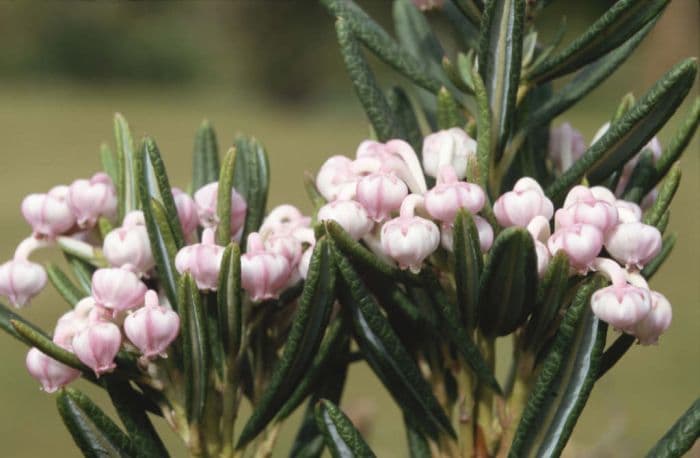
ABOUT
The Andromeda polifolia 'Compacta,' commonly known as "Bog Rosemary," is a small, evergreen shrub with a dense, mounded growth habit. This plant is notable for its fine, needle-like leaves that are similar in appearance to those of its namesake, the culinary rosemary, although the two plants are not related. The leaves of the Bog Rosemary are a striking bluish-green hue, sometimes exhibiting a silver or grayish tinge that adds to its allure. The foliage is also characterized by a leathery texture and often curls under at the edges. During the blooming season, Bog Rosemary produces small, bell-shaped flowers which dangle from short stalks. The charming flowers are typically a delicate pink color, creating a lovely contrast with the foliage. These blossoms may attract pollinators like bees to the garden. The overall appearance of the Bog Rosemary, with its intricate texture and alluring color palette, makes it a favorite among gardeners who seek to add a touch of evergreen elegance and cool-toned hues to their landscape.
About this plant
 Names
NamesFamily
Ericaceae.
Synonyms
Blue Ice Bog Rosemary, Compact Bog Rosemary.
Common names
Andromeda polifolia var. glaucophylla, Andromeda glaucophylla.
 Toxicity
ToxicityTo humans
Bog rosemary (Andromeda polifolia 'Compacta') is known to be toxic to humans if ingested. The plant contains andromedotoxins, which can interfere with the body's sodium channels and affect cardiac function. Symptoms of poisoning from bog rosemary may include vomiting, diarrhea, abdominal pain, and in severe cases, low blood pressure, respiratory problems, and potentially fatal cardiac complications. Ingesting any part of the plant can result in these toxic effects, so it's important to handle it with care and prevent accidental ingestion, particularly in children.
To pets
Bog rosemary (Andromeda polifolia 'Compacta') is also toxic to pets. Similar to its effects in humans, the andromedotoxins present in the plant can also cause serious health problems for animals. Symptoms of poisoning in pets may include vomiting, diarrhea, weakness, difficulty breathing, and can progress to more severe conditions such as seizures, coma, or even death if a significant amount is ingested. All parts of the plant are toxic and pets should be prevented from chewing or ingesting any portion of it.
 Characteristics
CharacteristicsLife cycle
Perennials
Foliage type
Evergreen
Color of leaves
Blue-green
Flower color
Pink
Height
1 foot (0.3 meters)
Spread
2 feet (0.6 meters)
Plant type
Shrub
Hardiness zones
2
Native area
Northern Hemisphere
Benefits
 General Benefits
General Benefits- Ornamental Value: Bog rosemary 'Compacta' is a popular ornamental plant due to its attractive blue-green foliage and pink flowers.
- Compact Growth: This cultivar remains small and compact, making it ideal for use in rock gardens, container gardening, or small spaces.
- Cold Tolerance: The plant is highly cold-tolerant, suitable for cooler climates and able to withstand frost.
- Low Maintenance: It requires minimal care, with no need for regular pruning or deadheading.
- Evergreen: As an evergreen, it provides year-round interest and color in the garden.
- Attracts Pollinators: Its flowers can attract bees and other pollinating insects, supporting local biodiversity.
- Drought Resistance: Once established, it has good drought tolerance, reducing the need for frequent watering.
- Pest Resistance: Bog rosemary 'Compacta' is generally resistant to pests and diseases, ensuring it remains healthy with less intervention.
- Soil Adaptability: It can grow in a range of soil types, though it prefers acidic, well-drained soils.
 Medical Properties
Medical PropertiesThis plant is not used for medical purposes.
 Air-purifying Qualities
Air-purifying QualitiesThis plant is not specifically known for air purifying qualities.
 Other Uses
Other Uses- Photography subjects: The Bog Rosemary 'Compacta's' delicate pink flowers provide an excellent opportunity for macro photography enthusiasts.
- Bonsai artistry: With its compact growth habit, the Bog Rosemary 'Compacta' can be trained as a bonsai specimen, offering a unique challenge due to its specific care requirements.
- Wildlife habitat enhancement: Planting Bog Rosemary 'Compacta' in garden settings can offer shelter and habitat for local insects and small wildlife.
- Thematic gardens: This plant can be used in Nordic or arctic-themed garden designs due to its natural habitat in cold peat bogs.
- Education and research: Botanists and horticulture students can study the Bog Rosemary 'Compacta' as a representative of acid-loving plants in a controlled setting.
- Dyestuff: The leaves and flowers might potentially be used to create natural dyes for textiles, though specific recipes and outcomes may vary widely.
- Eco-friendly groundcover: In suitable climates, Bog Rosemary 'Compacta' can serve as a sustainable, low-maintenance groundcover that reduces soil erosion.
- Cultural symbolism: In certain cultures, the idea of 'rosemary' is associated with remembrance, and this variety could be planted in memory gardens or as remembrance gifts, even though it is not a true rosemary.
- Art inspiration: The unique features of the Bog Rosemary 'Compacta' can provide artistic inspiration for painters and sculptors alike.
- Winter interest: In milder winter climates, the evergreen leaves of the Bog Rosemary 'Compacta' add a persistent green touch to the landscape when other plants may be dormant.
Interesting Facts
 Feng Shui
Feng ShuiThe Bog Rosemary is not used in Feng Shui practice.
 Zodiac Sign Compitability
Zodiac Sign CompitabilityThe Bog Rosemary is not used in astrology practice.
 Plant Symbolism
Plant Symbolism- Endurance - The andromeda plant is known for its hardy nature, able to survive in challenging environments such as boggy, acidic soils. This quality makes it a symbol of endurance and resilience.
- Protection - In mythology, the name 'Andromeda' refers to a princess who was saved from sacrifice. This connection lends the plant a symbolic meaning of protection and rescue from danger.
- Purity - The delicate, often white or pink flowers of the andromeda plant can symbolize purity and innocence due to their unblemished and dainty appearance.
- Beauty in solitude - Andromeda polifolia ‘Compacta’, with its preference for solitary bog habitats, can represent the idea that beauty and strength can be found even in isolation.
 Water
WaterBog rosemary requires consistently moist soil without becoming waterlogged. It's essential to water it deeply, providing about 1 gallon per week for an established plant, either all at once or divided into two waterings. During hot and dry periods, you might need to increase the frequency to maintain the soil's moisture, but always check the soil before adding more water to prevent overwatering. For container-grown plants, water until it runs out of the drainage holes, indicating sufficient saturation.
 Light
LightBog rosemary thrives in full sun to partial shade. To achieve optimal growth, place it where it will receive morning sunlight and some afternoon shade, especially in hotter climates. Avoid deep shade as this can lead to leggy growth and fewer flowers.
 Temperature
TemperatureBog rosemary prefers cooler climates and can withstand temperatures as low as -40 degrees Fahrenheit, although the ideal temperature range for this plant is between 60 and 70 degrees Fahrenheit. It may struggle in environments where temperatures consistently exceed 75 degrees Fahrenheit.
 Pruning
PruningPrune bog rosemary to maintain its compact shape and to remove any dead or damaged branches. Pruning is best done in late winter or early spring before new growth starts. It typically doesn't require heavy pruning; light trimming is enough to keep the plant tidy.
 Cleaning
CleaningAs needed
 Soil
SoilBog Rosemary prefers acidic soil with a pH between 4.5 and 5.5. A mix of peat moss, sand, and pine bark would create the ideal soil condition, ensuring proper drainage and replicating its natural boggy habitat.
 Repotting
RepottingBog Rosemary should be repotted every 2 to 3 years or when the plant shows signs of being root-bound. It's crucial to use an acidic soil mix to maintain optimal growth conditions.
 Humidity & Misting
Humidity & MistingBog Rosemary thrives at higher humidity levels, generally preferring above 50%. It's essential to recreate the plant's native humid conditions for successful growth.
 Suitable locations
Suitable locationsIndoor
Place in bright, indirect light and maintain high humidity.
Outdoor
Plant in partial shade, keep soil moist, and protect from wind.
Hardiness zone
2-6 USDA
 Life cycle
Life cycleThe life cycle of Andromeda polifolia 'Compacta', also known as Blue Ice Bog Rosemary, begins with seed germination, which occurs in a cold and moist substrate, mimicking the boggy conditions of its natural habitat. After germination, the seedling stage is marked by the development of the characteristic needle-like leaves and a slowly forming root system. As the plant enters the vegetative stage, it grows into a compact, rounded shrub, typically reaching no more than a foot in height and width. During the reproductive stage, Blue Ice Bog Rosemary produces clusters of small, bell-shaped pink flowers in late spring, which are pollinated by insects, leading to the production of tiny capsules containing seeds. After seed dispersal, the plant continues its growth, remaining evergreen throughout the year. Eventually, the plant ages and its growth slows, completing its life cycle over several years with the possibility of propagation through cuttings taken during its growth period.
 Propogation
PropogationPropogation time
Spring-Early Summer
Propogation: The most popular method of propagating the Bog Rosemary (Andromeda polifolia 'Compacta') involves semi-hardwood cuttings. The best time for this process is generally in later summer after new growth has partially matured. Cuttings should be about 4 to 6 inches (10 to 15 centimeters) in length and include several leaf nodes. The lower leaves are removed and the cut end is often dipped in rooting hormone to encourage root development. Then, the cuttings are planted in a moist, well-draining growing medium and covered with a plastic dome or placed in a greenhouse to maintain high humidity around the leaves. Roots usually form within a few weeks, after which the new plants can eventually be acclimatized to outdoor conditions and transplanted into the landscape.
